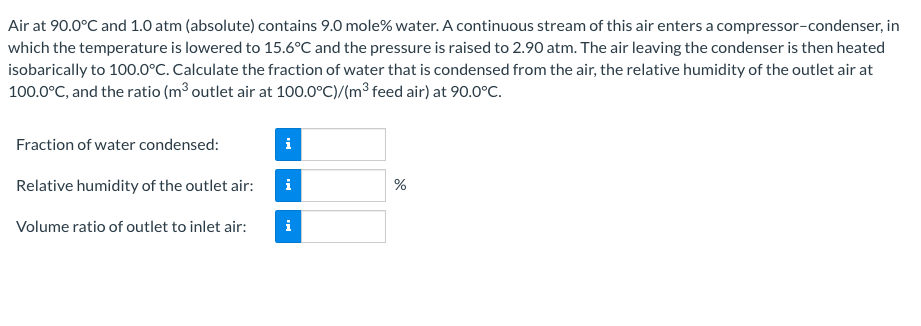Air at 90.0°C and 1.0 atm (absolute) contains 9.0 mole% water. A continuous stream of this air enters a compressor-condenser, in which the temperature is lowered to 15.6°C and the pressure is raised to 2.90 atm. The air leaving the condenser is then heated isobarically to 100.0°C. Calculate the fraction of water that is condensed from the air, the relative humidity of the outlet air at 100.0°C, and the ratio (m³ outlet air at 100.0°C)/(m³ feed air) at 90.0°C. Fraction of water condensed: Relative humidity of the outlet air: i Volume ratio of outlet to inlet air: i
Air at 90.0°C and 1.0 atm (absolute) contains 9.0 mole% water. A continuous stream of this air enters a compressor-condenser, in which the temperature is lowered to 15.6°C and the pressure is raised to 2.90 atm. The air leaving the condenser is then heated isobarically to 100.0°C. Calculate the fraction of water that is condensed from the air, the relative humidity of the outlet air at 100.0°C, and the ratio (m³ outlet air at 100.0°C)/(m³ feed air) at 90.0°C. Fraction of water condensed: Relative humidity of the outlet air: i Volume ratio of outlet to inlet air: i
Introduction to Chemical Engineering Thermodynamics
8th Edition
ISBN:9781259696527
Author:J.M. Smith Termodinamica en ingenieria quimica, Hendrick C Van Ness, Michael Abbott, Mark Swihart
Publisher:J.M. Smith Termodinamica en ingenieria quimica, Hendrick C Van Ness, Michael Abbott, Mark Swihart
Chapter1: Introduction
Section: Chapter Questions
Problem 1.1P
Related questions
Question
100%

Transcribed Image Text:Air at 90.0°C and 1.0 atm (absolute) contains 9.0 mole% water. A continuous stream of this air enters a compressor-condenser, in
which the temperature is lowered to 15.6°C and the pressure is raised to 2.90 atm. The air leaving the condenser is then heated
isobarically to 100.0°C. Calculate the fraction of water that is condensed from the air, the relative humidity of the outlet air at
100.0°C, and the ratio (m³ outlet air at 100.0°C)/(m³ feed air) at 90.0°C.
Fraction of water condensed:
i
Relative humidity of the outlet air:
i
Volume ratio of outlet to inlet air:
i
Expert Solution
This question has been solved!
Explore an expertly crafted, step-by-step solution for a thorough understanding of key concepts.
This is a popular solution!
Trending now
This is a popular solution!
Step by step
Solved in 4 steps with 4 images

Knowledge Booster
Learn more about
Need a deep-dive on the concept behind this application? Look no further. Learn more about this topic, chemical-engineering and related others by exploring similar questions and additional content below.Recommended textbooks for you

Introduction to Chemical Engineering Thermodynami…
Chemical Engineering
ISBN:
9781259696527
Author:
J.M. Smith Termodinamica en ingenieria quimica, Hendrick C Van Ness, Michael Abbott, Mark Swihart
Publisher:
McGraw-Hill Education

Elementary Principles of Chemical Processes, Bind…
Chemical Engineering
ISBN:
9781118431221
Author:
Richard M. Felder, Ronald W. Rousseau, Lisa G. Bullard
Publisher:
WILEY

Elements of Chemical Reaction Engineering (5th Ed…
Chemical Engineering
ISBN:
9780133887518
Author:
H. Scott Fogler
Publisher:
Prentice Hall

Introduction to Chemical Engineering Thermodynami…
Chemical Engineering
ISBN:
9781259696527
Author:
J.M. Smith Termodinamica en ingenieria quimica, Hendrick C Van Ness, Michael Abbott, Mark Swihart
Publisher:
McGraw-Hill Education

Elementary Principles of Chemical Processes, Bind…
Chemical Engineering
ISBN:
9781118431221
Author:
Richard M. Felder, Ronald W. Rousseau, Lisa G. Bullard
Publisher:
WILEY

Elements of Chemical Reaction Engineering (5th Ed…
Chemical Engineering
ISBN:
9780133887518
Author:
H. Scott Fogler
Publisher:
Prentice Hall


Industrial Plastics: Theory and Applications
Chemical Engineering
ISBN:
9781285061238
Author:
Lokensgard, Erik
Publisher:
Delmar Cengage Learning

Unit Operations of Chemical Engineering
Chemical Engineering
ISBN:
9780072848236
Author:
Warren McCabe, Julian C. Smith, Peter Harriott
Publisher:
McGraw-Hill Companies, The